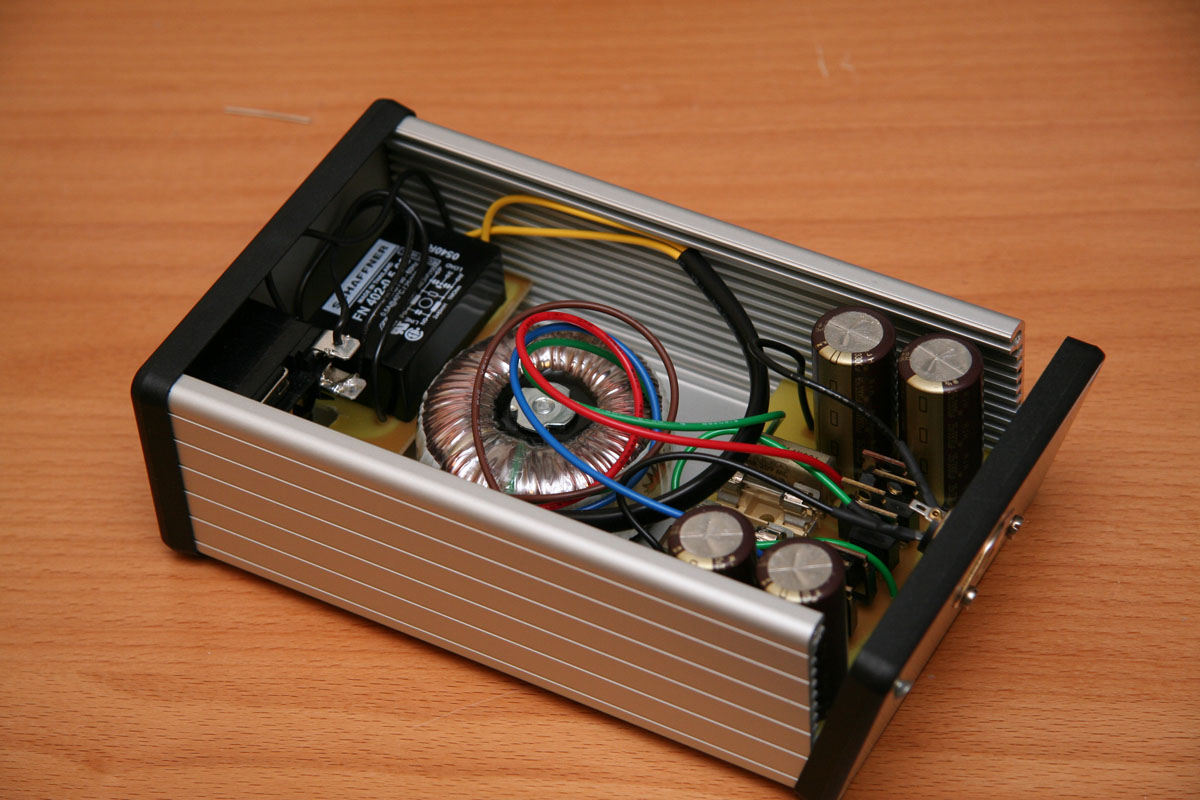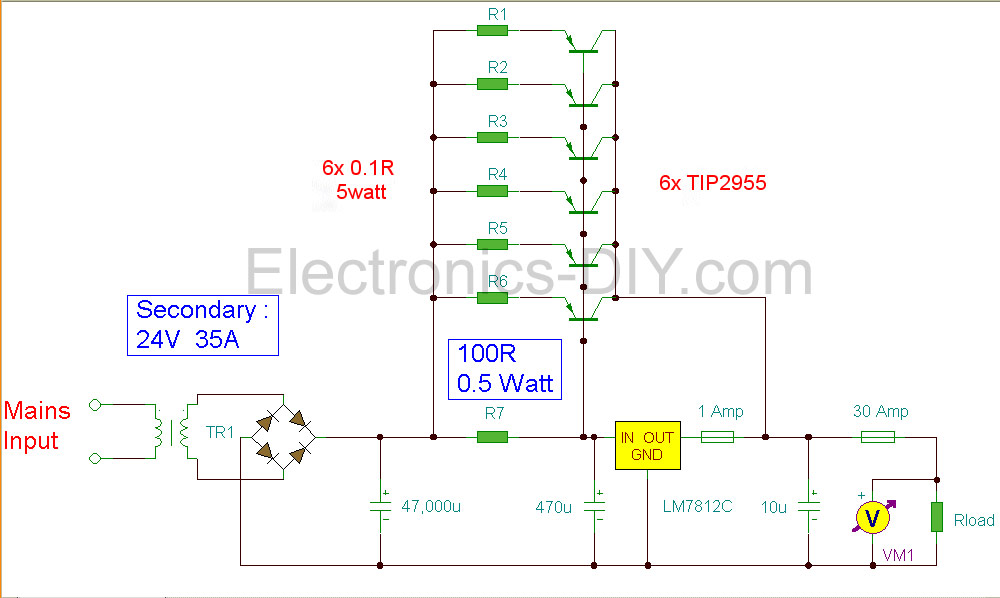
This is high current 12V power supply. Power supply uses LM7812 IC and can deliver up to 30A to the load by the help of the TIP2955 pass transistors. Each transistor can handle up to 5A and six of them result an total output current of 30A. You can increase or reduce the number of TIP2955s to get higher or lower current outputs. In this design the IC delivers about 800mA. A 1 amp fuse is connected after the LM7812 to protect the IC against high current transients. The transistors and the 12V regulator IC both require adequate heatsinking. When the load current is high, the power dissipation of each transistor also increases so excess heat may cause the transistors to fail. Then you will need a very large heatsink or fan cooling. 100Ω resistors are used for stability and prevent current swamping as the tolerances of dc current gain will be different for each transistor. The bridge rectifier diodes must be capable of passing at least 100 amps.

Notes
The input transformer is likely to be the most expensive part of the entire project. As an alternative, a couple of 12 Volt car batteries could be used. The input voltage to the regulator must be at least several volts higher than the output voltage (12V) so that the regulator can maintain its output. If a transformer is used, then the rectifier diodes must be capable of passing a very high peak forward current, typically 100amps or more. The 7812 IC will only pass 1 amp or less of the output current, the remainder being supplied by the outboard pass transistors. As the circuit is designed to handle loads of up to 30 amps, then six TIP2955 are wired in parallel to meet this demand. The dissipation in each power transistor is one sixth of the total load, but adequate heat sinking is still required. Maximum load current will generate maximum dissipation, so a very large heat sink is required. In considering a heat sink, it may be a good idea to look for either a fan or water cooled heat sink. In the event that the power transistors should fail, then the regulator would have to supply full load current and would fail with catastrophic results. A 1 amp fuse in the regulators output prevents a safeguard. The 400mohm load is for test purposes only and should not be included in the final circuit. A simulated performance is shown below:
Calculations
This circuit is a fine example of Kirchhoff's current and voltage laws. To summarize, the sum of the currents entering a junction, must equal the current leaving the junction, and the voltages around a loop must equal zero. For example, in the diagram above, the input voltage is 24 volts. 4 volts is dropped across R7 and 20 volts across the regulator input, 24 -4 -20 =0. At the output :- the total load current is 30 amps, the regulator supplies 0.866 A and the 6 transistors 4.855 Amp each , 30 = 6 * 4.855 + 0.866. Each power transistor contributes around 4.86 A to the load. The base current is about 138 mA per transistor. A DC current gain of 35 at a collector current of 6 amp is required. This is well within the limits of the TIP2955. Resistors R1 to R6 are included for stability and prevent current swamping as the manufacturing tolerances of dc current gain will be different for each transistor. Resistor R7 is 100 ohms and develops 4 Volts with maximun load. Power dissipation is hence (4^2)/200 or about 160 mW. I recommend using a 0.5 Watt resistor for R7. The input current to the regulator is fed via the emitter resistor and base emitter junctions of the power transistors. Once again using Kirchhoff's current laws, the 871 mA regulator input current is derived from the base chain and the 40.3 mA flowing through the 100 Ohm resistor. 871.18 = 40.3 + 830. 88. The current from the regulator itself cannot be greater than the input current. As can be seen the regulator only draws about 5 mA and should run cold.
Initial Testing and Faulting
For the initial test, do not connect a load. First use a voltmeter across the output terminals, you should measure 12 Volts, or very close to it. Then connect a 100 ohm, 3 Watt resistor or other small load. The reading on the voltmeter should not change. If you do not see 12 Volt, power off and check all connections.
I have heard from one reader whose supply was 35 Volt, not the regulated 12 Volts. This was caused by a short circuited power transistor. Should a short in any of the output transistors, occur, all 6 need to be un-soldered. Check with a multimeter set to resistance and measure between collector and emitter terminals. Power transistors usually fail short circuit so should be easy to find the faulty one.
A Finished Project
I've recently heard from Ryan Laurenciana in the Philippines who has built himself a 12V 30A power supply. Below are images from Ryans power supply.
[Scema-Electronic]
{ 0 komentar... Views All / Send Comment! }
Posting Komentar